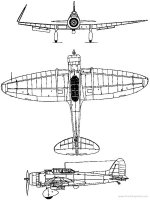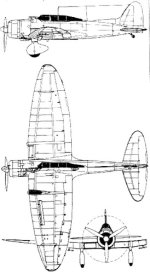Thank you!
Thank you very much Allen for this new effort of yours!



May I ask you if it would it be possible lowering the cockpit of your F4U1 "Birdcage" Corsair a little bit?
The difference in the cockpit position between the F4U1 and its development, the F4U1-A, is substantial.
Ltnt. Cdr. "Tommy" Blackburn, C.O. of VF-17, in his "The Jolly Rogers" memoirs explains in detail the contributions made by his squadron in teething the early F4U1, which led to the -A variant. Contributions not always acknowledge by other sources, since some vital modifications carried out in the field by VF-17 technicians, during the squadron pre-ops training months, like the stall-retarding spoiler welded to the leading edge of the Corsair left wing, are not attributed to VF-17 efforts.
Chance Vought, whose technicians were working side by side with VF-17 mechanics and technical officer, made these fields mods standard features in the -A production run. The leading edge spoiler, a standard feature of the U1-A and later variants, corrected the vicious habit of the Birdcage Corsair to stall suddenly the left wing at low speeds without warning. With this mod, the -A low speed stall characteristics became more gentle and gave enough warning to the pilot.
Low speed control was vital in an airplane designed for carrier operations.
VF-17 also developed the very first ventral bomb rack for the Corsair, utilising the bolts for the catapult hooks.
You can read a nice summary of Blackburn's book here:
http://acepilots.com/usn_blackburn.html
Blackburn's involvement in Operation Torch must also be noted.
One of the main complaints from VF-17 pilots was the terrible lack of forward visibility, determined by the low cockpit of the Birdcage Corsair combined with the F4U huge nose. Another negative aspect in view of future carrier ops.
VF-17 was the first Navy squadron to be equipped with the new Corsair, Chance Vought had invested heavily in the new fighter and the Bridgeport, CT company future was very much at stake, depending 100% upon the Corsair success or failure. The same poor pilot's visibility complaint came from Marines units that had already tried the F4U1 in combat over Guadalacanal.
Chance Vought responded promptly to this request, by replacing the "birdcage" canopy with a new blown Perspex "bubble" canopy and by raising several inches the entire cockpit.
This gave the definitive look of the classic F4U1-A Corsair and later variants, with both a tapered nose and rear fuselage, culminating with the cockpit canopy. VF-17 deployed in combat the very first "dash A" Corsairs.
Watching the two aircraft variants standing side by side, the difference in cockpit height and fuselage shape between the U1 and the U1-A is quite evident. The fuselage shape and cockpit height of this F4U1 shows its legacy from the stock CFS2 F4U1-A Corsair. If modifying it would be too complicated, don't bother. No problem!
Cheers!
KH 






 Many thanks.
Many thanks.



